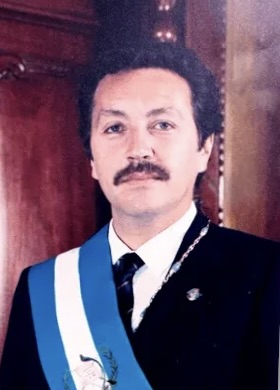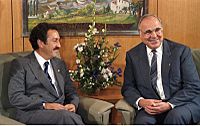Vinicio Cerezo facts for kids
Quick facts for kids
Vinicio Cerezo
|
|
|---|---|

Official portrait, 1986
|
|
| 40th President of Guatemala | |
| In office January 14, 1986 – January 14, 1991 |
|
| Vice President | Roberto Carpio Nicolle |
| Preceded by | Óscar Humberto Mejía |
| Succeeded by | Jorge Serrano Elías |
| General Secretary of Central American Integration System | |
| In office June 29, 2017 – June 29, 2021 |
|
| Preceded by | Victoria Marina Velásquez |
| Succeeded by | Werner Vargas Torres |
| Personal details | |
| Born | December 26, 1942 Guatemala City |
| Political party | Guatemalan Christian Democrats |
| Spouse |
Raquel Blandón
(m. 1965; div. 2006) |
Marco Vinicio Cerezo Arévalo (born December 26, 1942) is a Guatemalan politician. He served as the 40th President of Guatemala from 1986 to 1991. He was the first president elected by the people after a long period of military rule. He also worked as the Secretary General of the Central American Integration System (SICA) from 2017 to 2021. During his time as president, he faced many challenges. He worked to bring peace and democracy to Guatemala.
Contents
Early Life and Political Journey
Vinicio Cerezo was born in Guatemala City. His father was a judge. In 1962, he was a student at the Universidad de San Carlos de Guatemala (USAC). He joined student protests against the government. In 1964, he became a member of the Guatemalan Christian Democrats (DCG). This was a political party that was not allowed to take part in elections at first.
He finished his law studies at USAC in 1968. That same year, the DCG party became legal. He became the party's secretary in 1970. Because of the difficult political times, he needed constant protection. In 1981, his car was attacked in the capital city. This was one of several attempts on his life.
Becoming a Leader
In 1974, the DCG party joined with others to support a presidential candidate. Cerezo was elected as a deputy in the National Congress. The DCG became the biggest opposition party.
Later, in 1978, the DCG's candidate came in second place in the presidential election. During this time, many members of the DCG party were killed. The few surviving members of Congress had to hide for their safety.
In 1982, Cerezo supported an opposition candidate in the elections. When the results seemed unfair, he and his supporters spoke out. Soon after, a military leader named Efraín Ríos Montt took power. This was a "coup," meaning the government was changed by force. Cerezo first supported this change. However, he later asked for new elections when he saw how the new government was acting.
In 1983, another military leader, Óscar Humberto Mejía, took power. Cerezo carefully supported this change. In 1984, the DCG party did very well in the National Congress elections. They won the most seats. Because of this success, the DCG decided that Cerezo should run for president in 1985. He started talking about the idea of peace talks with the main rebel groups.
President of Guatemala (1986-1991)
In the 1985 presidential elections, Vinicio Cerezo won the first round. Then, in the second round, he won with a large number of votes. He became the first president elected by the people since 1966. Many people had high hopes for his presidency. He promised to keep public order and change Guatemala.
One of his first actions was to ask a high-ranking army officer to retire. He also named a new Minister of Defence. This showed he was ready to make important decisions.
Challenges and Peace Efforts
During his time as president, there were new waves of violence. Many people were killed. Cerezo worked hard to stop these problems. He declared that Guatemala would stay neutral in the civil wars happening in nearby countries like El Salvador and Nicaragua.
He strongly supported the idea of a Central American Parliament. This would help countries in Central America work together. He also helped organize important meetings in Esquipulas. These meetings led to a plan for lasting peace in the region in 1987. This was a very important step for peace in Central America.
In 1987, he created the National Commission for Reconciliation. This group aimed to bring peace. Negotiations between the government and rebel groups began but did not succeed at first. Cerezo asked the United States for more military help. Congress also passed a law that offered forgiveness for some political crimes.
There were rumors of plots against Cerezo. In 1988, there was an attempt by some military units to make demands on the government. Cerezo said he had to agree to some of their demands to avoid a bigger problem. In August, there was a three-week strike because of rising fuel prices.
Moving Towards Democracy
The political situation remained difficult in 1989. There were many killings and kidnappings. Another attempt to overthrow the government failed in May. Even though the people responsible were sentenced, they were later released. In August, a leader of Cerezo's party was killed. However, Cerezo promised to improve the government and strengthen democracy. Guatemala has remained a democracy since then.
In 1990, Cerezo's government and the rebel groups signed an agreement. They promised not to disrupt the upcoming elections. With this success, Cerezo felt good about his time as president. He handed power to the next elected president, Jorge Serrano Elías. This was the first peaceful transfer of power between elected leaders since 1951.
In 1990, Cerezo also invited a famous Russian expert, Yuri Knorozov, to Guatemala. Knorozov had helped understand ancient Maya hieroglyphics. This was the first time he could visit the lands of the ancient Maya civilization.
After His Presidency
After leaving office in 1991, Cerezo became a deputy in the Central American Parliament. This is a group that works for cooperation among Central American countries.
He continued to be involved in politics. In the 1999 and 2003 elections, he won seats in the National Congress. In the 2007 election, he lost his seat. His son, also named Vinicio Cerezo, ran for president but did not win.
Vinicio Cerezo is now working on a non-governmental organization (NGO) called Esquipulas. It is named after the peace agreements he helped create. This organization aims to further unite Central America. He also works as a political advisor.
On June 29, 2017, he was named the Secretary-General of the Central American Integration System (SICA). On August 7, 2017, the Guatemalan Government named him a Peace Ambassador. This was on the anniversary of the Esquipulas II agreements.
See also
 In Spanish: Vinicio Cerezo para niños
In Spanish: Vinicio Cerezo para niños


